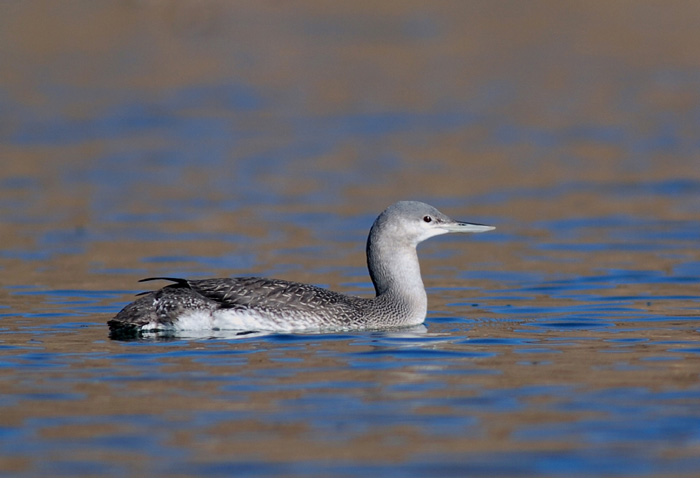
Gavia stellata
TAXONOMY
Colymbus stellatus Pontoppidan, 1763, Tame River, Warwickshire,
England. Monotypic.
OTHER COMMON NAMES
English: Red-throated diver; French: Plongeon catmarin; German:
Sterntaucher; Spanish: Colimbo Chico.
PHYSICAL CHARACTERISTICS
20.8–27.19 in (53–69 cm); 2.2–5.9 lb (1.0–2.7 kg). The smallest
and least robust in the family, with proportionally smaller, upturned
bill and smaller feet than other loons. Smaller size allows
red-throated loons to take off directly from water and
even from land. In alternate plumage, has grayish upperparts,
white underparts, gray face, and brick red throat patch. In basic
plumage, has grayish upperparts with white speckling, gray
cap and nape, white underparts, throat, and face. Juvenal and
second alternate plumages similar to basic plumage, with graybrown
wash on head and neck.
DISTRIBUTION
Breeding range is circumpolar, ranging farther north than
other loons. Occupies coastal plain in Alaska, northern Canada,
Greenland, Iceland, northern British Isles, Norway, Sweden,
Finland, and across Russia. Winters on coasts on Atlantic and
Pacific Oceans north of the tropic of Cancer, occasionally found
inland. Migrates mostly along coast, occasionally over land.
HABITAT
Breeds mainly on ponds in coastal tundra, occasionally inland
up to 3,511 ft (1,070 m) in elevation. Where it competes with
other loons, occupies smaller (sometimes fishless) ponds too
small for larger loons. In the far north where it is the only
loon present, will breed on larger ponds and lakes. Winters on
coasts, usually within 3 mi (5 km) of shore in areas with a soft,
sandy substrate. Occasionally found inland on large lakes and
rivers.
BEHAVIOR
The only loon to have duet vocalizations, given by pairs on
breeding ponds. May migrate singly or in loose flocks. Does
not require running start from water during take-off like other
loons, and is the only loon that can take off from land.
FEEDING ECOLOGY AND DIET
Feeds on variety of small freshwater and marine fish. Will feed
invertebrates to small chicks, and will feed on invertebrates as
adults when fish are scarce. When breeding in fishless ponds,
will fly to the coast and other ponds to catch prey to bring
back to the young.
REPRODUCTIVE BIOLOGY
Breeds from May to September, depending on latitude and climate.
Incubation 24–27 days. Occasionally moves from breeding
pond to a larger pond or the ocean. Chicks are more agile on
land than are adults, and have been seen traveling over a kilometer
over land. Young can fly after 38 days. Predators include
Arctic fox (Aloplex lagopus) and other mammals, jaegers (Stercorarius),
and gulls (Larus).
CONSERVATION STATUS
Declining over much of its range, although the cause is unknown.
Not listed on IUCN Red List of Threatened Birds.
SIGNIFICANCE TO HUMANS
Inuit legally hunt around 4,600 loons (of all species) each year
for subsistence; the proportion that are red-throated is unknown.
Other popular Animals
Photo Gallery of - Red-throated loon




 Animalia Life
Animalia Life